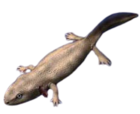Rhinatrema
Appearance
| Rhinatrema | |
|---|---|
| Scientific classification | |
| Domain: | Eukaryota |
| Kingdom: | Animalia |
| Phylum: | Chordata |
| Class: | Amphibia |
| Order: | Gymnophiona |
| Clade: | Apoda |
| Family: | Rhinatrematidae |
| Genus: | Rhinatrema Duméril and Bibron, 1841 |
| Type species | |
| Caecilia bivittata Guérin-Méneville, 1838
| |

Rhinatrema is a genus of caecilians in the family Rhinatrematidae.[1][2] Their common name is two-lined caecilians. The genus is known from the Guyanas (Guyana, French Guiana, and Suriname) and adjacent Brazil.[1] Most Rhinatrema are known to inhabit and live in areas of tropical forests where there is an abundance of dense, dead vegetation matter.[3]
Rhinatrema are primitive caecilians that have a true tail. They are oviparous.[4]
Until recently, the two-lined caecilian (R. bivittatum) was the only species in the genus Rhinatrema. However, in 2010 and 2018, new species were described. The genus now contains now six species:[1][2]
| Binomial name and author | Distribution | Status |
|---|---|---|
| Rhinatrema bivittatum (Guérin-Méneville, 1838) | Guyana, Surinam, French Guiana, Brazil | Least Concern[5] |
| Rhinatrema gilbertogili Maciel, Sampaio, Hoogmoed, and Schneider, 2018 | Brazil | Not evaluated |
| Rhinatrema nigrum Dunn, 1942 | Guyana, Venezuela, possibly Brazil | Least Concern[6] |
| Rhinatrema ron Wilkinson and Gower, 2010 | Brazil | Not evaluated |
| Rhinatrema shiv Gower, Wilkinson, Sherratt, and Kok, 2010 | Guyana | Not evaluated |
| Rhinatrema uaiuai Maciel, Sampaio, Hoogmoed, and Schneider, 2018 | Brazil | Not evaluated |
References
[edit]- ^ a b c Frost, Darrel R. (2014). "Rhinatrema Duméril and Bibron, 1841". Amphibian Species of the World: an Online Reference. Version 6.0. American Museum of Natural History. Retrieved 29 May 2014.
- ^ a b "Rhinatrematidae". AmphibiaWeb: Information on amphibian biology and conservation. [web application]. Berkeley, California: AmphibiaWeb. 2014. Retrieved 29 May 2014.
- ^ Jared, C; Navas, C.A; Toledo, R.C (1999). "An appreciation of the physiology and morphology of the Caecilians (Amphibia: Gymnophiona)". Comparative Biochemistry and Physiology Part A: Molecular & Integrative Physiology. 123 (4): 313–328. doi:10.1016/S1095-6433(99)00076-8.
- ^ Vitt, Laurie J.; Caldwell, Janalee P. (2014). Herpetology: An Introductory Biology of Amphibians and Reptiles (4th ed.). Academic Press. p. 449.
- ^ Philippe Gaucher; Ross MacCulloch; Mark Wilkinson; Marvalee Wake (2004). "Rhinatrema bivittatum". IUCN Red List of Threatened Species. 2004: e.T59647A11975672. doi:10.2305/IUCN.UK.2004.RLTS.T59647A11975672.en. Retrieved 26 April 2023.
- ^ IUCN SSC Amphibian Specialist Group. (2020). "Rhinatrema nigrum". IUCN Red List of Threatened Species. 2020: e.T59643A109542103. doi:10.2305/IUCN.UK.2020-3.RLTS.T59643A109542103.en. Retrieved 26 April 2023.




